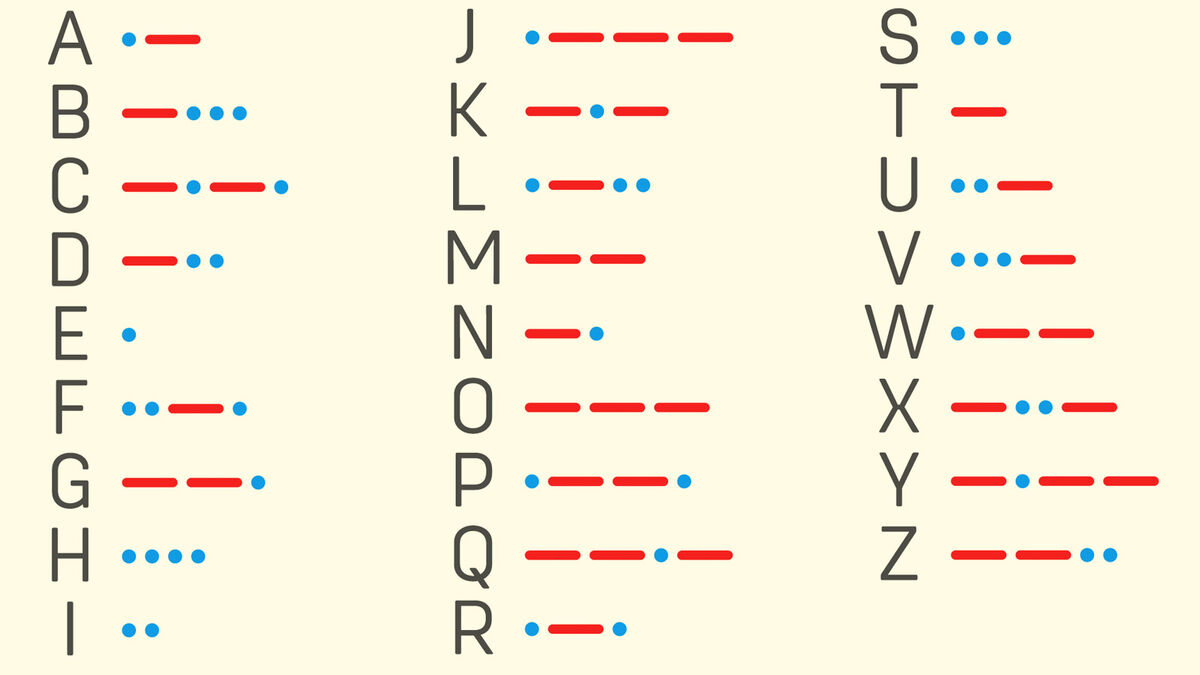
Morse code used to be the only form of long distance communication in the early days of the telegraph. Today, it’s not such a hot commodity given the advent of the phone and the Internet. However, amateur radio enthusiasts still use Morse code abbreviations to communicate. If you’re interested in Morse code, learn some standard Morse code abbreviations including prosigns.
One and Two Letter Morse Code Abbreviations
Morse code (CW or continuous wave) is a radio signal that uses a series of dots and dashes (usually as audible beeps or flashes of light) to signify letters. Not only was it used as an early means of communication with the telegraph, but Morse code is also popular among amateur radio enthusiasts. So, several different abbreviations have been created over the years.
Given the simplicity of this mode of communication, abbreviations save time. Check out some quick 1-2 code abbreviations used around the world.

0-E Code Abbreviations
Not only can you tell someone that you want to send them “love and kisses,” but also pretty much everything in between. Quickly find the abbreviation you need here for 0-E.
- 30 - I have no more to send
- 73 - Best regards
- 88 - Love and kisses
- AA - All after
- AB - All before
- AM - Amplitude modulation
- BK - Break, break-in
- BN - All between; been
- BT - Separation (add a space)
- B4 - Before
- C - Yes, correct
- CK - Check
- CL - I am closing my station; call
- CQ - Calling any station
- CU - See you
- DA - Day
- DE - From; this is
- DN - Down
- DR - Dear
- DX - Distance
- EL - Element
- ES - And
F-N Morse Code Abbreviations
Morse code is a diverse short-hand language. Not only can it be used in beeps, but it works with lights too. Send your signals for “from” to “now” using these abbreviations.
- FB - Excellent
- FM - Frequency modulation; from
- GA - Go ahead; good afternoon
- GB - Goodbye
- GD - Good
- GE - Good evening
- GG - Going
- GM - Good morning
- GN - Good night
- GV - Give
- HH - Error in sending
- HI - The telegraph laugh; high
- HQ - Headquarters
- HR - Here; hear
- HV - Have
- HW - How, how copy?
- LV - Leave
- MA - Milliamperes
- N - No; negative; incorrect
- ND - Nothing doing
- NM - No more
- NR - Number
- NW - Now; I resume transmission
O-Y Code Abbreviations
From “old chap” to “year,” you are covered when it comes to Morse code. If you’re looking for a short abbreviation from O-Y, you’re in the right place.
- OB - Old boy
- OC - Old chap
- OM - Old man
- OP - Operator
- OT - Oldtimer; old top
- PT - Point
- PX - Press
- R - Received as transmitted; are; decimal point
- RC - Ragchew
- RE - Concerning; regarding
- RX - Receive, receiver
- SS - Sweepstakes
- T - Zero
- TR - Transmit
- T/R - Transmit/receive
- TT - That
- TU - Thank you
- TX - Transmitter; transmit
- U - You
- VY - Very
- W - Watts
- WA - Word after
- WB - Word before
- WD - Word
- WL - Well; will
- WX- Weather
- YL - Young lady
- YR - Year
Three or More Letter Abbreviations
Trying to condense all Morse code abbreviations down to just one or two letters would be an impossibility. Not only would you have overlap, but it just wouldn’t make sense for some words.
In these instances, Morse coders might create abbreviations with three or more letters. This might be by removing the vowels or just having an arrangement that is recognizable like “ANT” for “antenna” or “BTR” for “better.”
Look familiar texters? The texting language has been around for a long time. Now it is time to jump into the abbreviations.
A-G Morse Code Abbreviations
If you need to know the shorthand code for “about” or “message,” then this is your list. Just follow the alphabetical order to find what you are looking for.
- ABT - About
- ADEE - Addressee
- ADR - Address
- AGN - Again
- ANT - Antenna
- BCI - Broadcast interference
- BCL - Broadcast listener
- BCNU - Be seeing you
- BTR - Better
- BUG - Semi-automatic key
- CFM - Confirm; I confirm
- CLBK - Callbook
- CLD - Called
- CLG - Calling
- CNT - Can't
- CONDX - Conditions
- CKT - Circuit
- CUL - See you later
- CUM - Come
- DIFF - Difference
- DLD - Delivered
- DLVD - Delivered
- FER - For
- GND - Ground
- GUD - Good
- GESS - Guess
- GVG - Giving
H-R Morse Code Abbreviations
Almost there! Not only will you find some technical codes like “received” and “radio frequency interference,” but you will also find fun code abbreviations like “poor operator.”
- HPE - Hope
- IMI - Repeat; say again
- INFO - Info
- LID - A poor operator
- LNG - Long
- LTR - Later; letter
- LVG - Leaving
- MILL - Typewriter
- MSG - Message; prefix to radiogram
- NCS - Net control station
- NIL - Nothing; I have nothing for you
- OPR - Operator
- PBL - Preamble
- PKG - Package
- PSE - Please
- PWR - Power
- RCD - Received
- RCVR - Receiver
- REF - Refer to; referring to; reference
- RFI - Radio frequency interference
- RIG - Station equipment
- RPT - Repeat, report
- RTTY - Radio teletype
- RST - Readability, strength, tone
S-X Morse Code Abbreviations
You’re now reaching the end of your Morse code abbreviation fun. Find everything that you’ll need from “signal” to talking about your “wife” here.
- SASE - Self-addressed, stamped envelope
- SED - Said
- SEZ - Says
- SGD - Signed
- SIG - Signature; signal
- SINE - Operator's personal initials or nickname
- SKED - Schedule
- SOS - signal for help needed
- SRI - Sorry
- SSB - Single sideband
- STN - Station
- SUM - Some
- SVC - Service; prefix to service message
- TFC - Traffic
- TMW - Tomorrow
- TNX - Thanks
- TRIX - Tricks
- TTS - That is
- TVI - Television interference
- TXT - Text
- UR - Your; you're
- URS - Yours
- VFB - Very fun business
- VFO - Variable frequency oscillator
- WDS - Words
- WID - With
- WKD - Worked
- WKG - Working
- WPM - Words per minute
- WRD - Word
- WUD - Would
- XCVR - Transceiver
- XMTR - Transmitter
- XTAL - Crystal
- XYL - Wife
Morse Code Prosign Abbreviations
The word “prosigns” is an abbreviation itself; it’s short for “procedural signals.” These procedural signals go back to the beginnings of Morse code creation and are basic procedures that you should use, for example, to send messages or to sign off.
Standard prosign abbreviations include:
- AR - End of message
- AS - Stand by
- BK - Invite receiving station to transmit
- BT - Pause; break for text
- KA - Beginning of message
- KN - End of the transmission
- CL - Going off the air (clear)
- CQ - Calling any amateur radio station
- K - Go, invite any station to transmit
- KN - Go only, invite a specific station to transmit
- R - All received OK
- SK - End of contact (sent before call)
- VE - Understood
Speaking With Code
You don’t have to be an amateur radio enthusiast to learn Morse code. Learning the code can be a fun way to communicate if you get walkie-talkies for your birthday. It almost feels like you know a secret language. For more information on fun abbreviations, dive into texting abbreviations. You might even find some similarities.